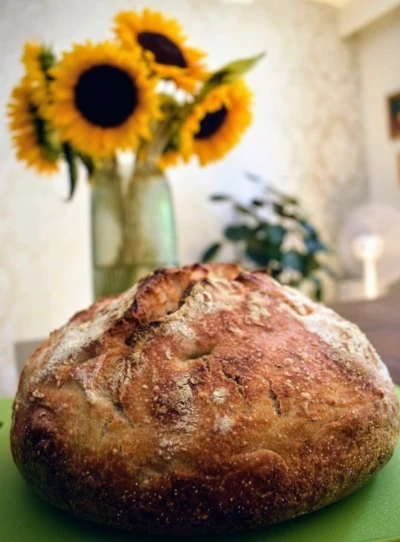Country Crust Sourdough Bread

Pies, cakes, and other sweets are sure to please most any dinner guest but a stellar homemade sourdough bread is the real centerpiece in a home baker’s arsenal of tastes. Granny’s Country Crust Sourdough Bread is soft and delicate on the inside, surrounded by a crispy, crackling crust with just the right amount of sourdough tanginess. Break out this bread to impress your friends on a special occasion or use it as an everyday staple for sandwich lunches.
This bread is baked in a cast iron dutch oven, which gives the loaves their beautiful round shape. The cast iron also plays an important role in transmitting the oven’s heat to the outside of the bread, allowing it form such a crunchy, delectable crust. Because the dutch oven is really vital to the success of this recipe, we don’t recommend substituting in a different baking container.
The recipe may look complex, but don’t be intimidated. A lot of steps are spread over three days but most of that time is spent waiting on dough to rise. Additional rise time is needed for this recipe because it makes use of a preferment “sponge” that needs to rise itself before being incorporated into the final dough. The sponge technique is used to enhance the bread’s flavor with the distinctive tang of sourdough. Before you get started, be sure you have an active Sourdough Starter.

Ingredients
Preferment Sponge
30 grams sourdough starter 160 grams white flour 140 grams warm water
Bread Dough
800 grams white flour 80 grams wheat flour 700 grams water 20 grams salt 230 grams sponge 1 tablespoon dry yeast (optional)
Method
- Day 1
Morning: Feed your sourdough starter. Dump out about half of the starter and feed the remainder with equal parts flour and warm water. Read more about how to maintain a sourdough starter.
Evening: Feed the sourdough starter again as above. - Day 2
Morning: Make the preferment sponge. Combine 160 grams flour, 140 grams warm water, and 30 grams of the now fed and active sourdough starter. Stir well, cover loosely with plastic wrap or a damp kitchen towel and let it sit in a warm spot.
Evening: Make the dough. Combine 800 grams white flour, 80 grams wheat flour, 700 grams water. Mix well and let sit for one hour. Then add 20 grams salt, 230 grams sponge, and a pinch of dry yeast if you want to. The yeast will add some extra rise to the dough which is helpful when baking in cooler weather. Knead well by hand or with a stand mixer, adding more flour as needed. Put the dough in a floured container, cover loosely so gas can escape, and let it sit out overnight to rise.
- Day 3
Morning: Put the dough onto a floured surface and divide in two. Shape each piece into a round loaf. Put each loaf into a floured container, cover loosely, and put in the fridge for the "proofing" stage.
Evening: After about six hours in the fridge, you're ready to bake. Place a cast iron dutch oven into the oven and preheat to 450 F (230 C). Then add a sprinkle of cornmeal to the bottom to prevent sticking and add the dough. Bake for 30 minutes with the lid on, then 15 minutes with it off. Take out and let it cool well.

The Alchemy of Sourdough
Sourdough bread, with its distinctive tangy flavor and hearty texture, is indeed a timeless classic that has been a staple in many cultures for thousands of years. The history of sourdough is as rich and complex as its flavor, dating back to ancient civilizations. It's believed that the earliest forms of leavened bread were likely the result of wild yeasts present in the environment or on the grains themselves. These wild yeasts would ferment the dough, causing it to rise and develop a unique flavor profile.
The process of making sourdough is a beautiful blend of science and art. It involves fermenting dough using naturally occurring lactobacilli and yeast. This fermentation process is what gives sourdough its characteristic tangy flavor, chewy texture, and hearty crust. The name "sourdough" itself is a nod to this unique taste, which sets it apart from other types of bread.
But sourdough is more than just its taste. The process of creating a sourdough starter, nurturing it, and using it to bake bread is a tradition passed down through generations. It's a connection to our past, a testament to human ingenuity and the ability to harness the natural environment to create sustenance. It's a reminder of a time when bread was made slowly, with care and patience, a far cry from the mass-produced loaves many of us are familiar with today.
In many ways, sourdough bread is a symbol of resilience and sustainability. The same starter can be kept alive and used for many years, and some bakeries even boast starters that are several generations old. This continuity adds another layer of depth to the already rich history of sourdough bread, making each loaf a part of a long, ongoing story that connects us to our ancestors.
Granny's Country Crust Sourdough Bread is a nod to this age-old tradition. This recipe is unique in its use of a preferment "sponge", a technique that enhances the bread's flavor with the distinctive tang of sourdough. The sponge needs to rise before being incorporated into the final dough, which is why the recipe is spread over three days. This might seem complex, but most of that time is spent waiting for the dough to rise.
This recipe is more than just a method of making bread; it's a journey back in time, a way to connect with our roots and experience the simple, wholesome goodness of homemade sourdough bread. Whether you're looking to impress your friends on a special occasion or seeking an everyday staple for sandwich lunches, Granny’s Country Crust Sourdough Bread is a recipe worth mastering.